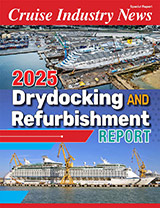The opening of the Portimão Cruise Port quay in April 2008 to large cruise ships without any tidal constraints is the main new feature presented by the Algarve port in southern Portugal.
The dredging work, which is now complete, will reestablish the depth at -8 metres, both in the access channel and in the turning (350 metres diameter) and berthing basins, ensuring complete safety conditions for the entrance of ships over 210 metres in length.
In practice, almost all the ships that currently call at Portimão can dock at the quay, instead of anchoring off shore, providing greater safety and comfort for passengers.
The reestablishing of the depth by the Port and Sea Transport Institute began on 19 October 2007 and is now complete, with more than 435 thousand cubic metres of sand and mud will having been removed.
Complying with a strict environmental monitoring programme, the spoils resulting from the dredging will be deposited off shore, at two specific sites (at 6.1 miles and 7.3 miles), according to the level of contamination of the material to be deposited.
Well aware of its role in the good environmental management of the area, the port administration contracted the supervision of this work from the National Institute of Biological Resources for around 47 thousand euros. The contract programme includes the monitoring of surface water quality at the dredging site and at the sites where the spoils are deposited. An assessment is also made of their effects on the biota at the disposal site, through the capture of fish, molluscs and benthic communities (organisms that live in the substratum).
As Portimão Estuary is an important example of the maritime activities of the people who inhabited the Southwest of the Iberian Peninsula, the intervention also ensures the preservation of its valuable archaeological heritage. Preliminary archaeological prospection work was carried out on the bed river, to the value of almost 83 thousand euros, by a team from the National Centre of Maritime and Underwater Archaeology, which is part of the Institute of Architectural and Archaeological Heritage Management (IGESPAR). The objective was to ensure that the dredging work would not damage any archaeological traces.



